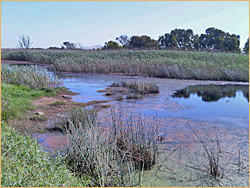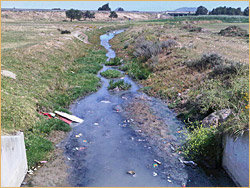|
EVENTS YOU NEED TO ATTEND! |
|
Evening Talk at
Rietvlei: |
“Overview of students projects
for 2011” Five nature
conservation students have spent
this year working in Rietvlei,
Blaauwberg and Atlantis
conservation areas and have some
interesting projects to share
from their studies.
|
Speakers: North region
nature conservation students
Where: Rietvlei Education
Centre, off Grey Avenue Flamingo
Vlei
When: Thursday 10
November @ 19h30 for 20h00.
View the sunset over the
vlei waters at Rietvlei!
Contact: Pat on 083 701 4318 |
This will be our end-of-year
function so we would like to
request all members to bring a
plate of eats to share. We will
have wine, juice, tea and coffee
available.
◊ PLEASE SUPPORT THE STUDENTS ◊
|
 |
|
Evening Talk at BCA: |
|
“Understanding informal economy
of illicit harvesting within
City of Cape Town” |
Speaker: Leif Petersen
(University of Queensland,
Australia)
Where: Log Cabin, Eerste
Steen, Otto du Plessis Drive,
between Big Bay and
Melkbosstrand. View
another sunset from the beach!
When: Tuesday 15 November @
19h30 for 20h00
Contact: Roy on 071 671 9552 |
|
This promises to be a
fascinating presentation by an
overseas speaker. |
 |
|
SEVERE POLLUTION IN THE DIEP RIVER |
|
On Friday 14 October numbers of
fish were found dying in the
Diep River just north of the
Blaauwberg Road Bridge. Nearly
40 dead carp were counted in a
stretch of about 150 meters. The
water in the river was visibly
polluted and it is suspected
that the source is one or more
of the stormwater drains into
the river upstream of the
bridge. |
 |
 |
|
Diep River at Lookout
Point |
Du Noon Stormwater
Outfall |
|
|
Needless to say, birds soon
discovered the dead fish and a
few hours later more than 55
pelicans were counted together
with large numbers of ibis,
herons, egrets, etc. A couple of
days later most of the dead fish
were gone and the birds had also
moved on. |
|
We have not received the water
quality results for October, but
the results for the end of
September (sampled on 27
September) show high levels of
pollutants at the Blaauwberg
Road bridge. Total Nitrogen was
2.9 mg/l, this was about the
average level measured in the
river that day; the acceptable
level is less than 2.5mg/l.
Total Phosphate was 0.98 mg/l,
the highest level in the river
that day; the acceptable level
is less than 0.25 mg/l.
Dissolved oxygen was measured at
3.1 mg/l, about average for the
river, excluding the estuary, on
that day, this was about 30%
saturation – not exceptionally
low for periods of low water
flow.What is disturbing is that
the faecal coliform bacterial
count was extremely high, at
45,000 /100ml it was more than 3
times the level measured
downstream of the Potsdam
discharge point. The water
quality guideline for
“intermediate contact (not
swimming)” is a maximum of 1,000
/100ml. This means that the
levels of bacteria were 45 times
higher than it should be for
safe human contact. |
|
The level at the N7 bridge was
only 320 /100ml; which clearly
indicates that the source of the
pollution was between the N7
bridge and Blaauwberg Road and
thus most likely one of the
stormwater outfalls in this
section of the river. |
|
The situation has been reported
to the City’s stormwater
department. We realize that
polluted stormwater is a major
problem in the City, and we hope
that the recently completed
study of the stormwater
discharges on the eastern shore
of the Diep River from the mouth
to the N7 bridge will lead to a
resolution of this particular
problem. |
|
Another concern we have
following the fish deaths and
the increase in stormwater
pollutants is the pressure from
Milnerton Estates and Aska
Properties for the city to
reduce the approved buffer along
the Diep River on their
Rivergate Development. This area
is on the western side of the
Diep River north of the railway
bridge. The city has already
built its portion of the M12
road from the N7 and across the
Diep River. The developers are
supposed to be completing the
link road from Sandown road to
the M12. The developers excuse
for not building their portion
appears to be aimed at getting
more development rights out of
the authorities. They wish to
have the stormwater polishing
undertaken within the river
corridor. Based on the bad
quality of stormwater entering
the Diep River from the areas
such as Killarney Gardens and Du
Noon we do not want to see the
new developments following the
same methods. Stormwater needs
to be polished by removing
pollutants and litter before it
gets to the river corridor.
Unfortunately for developers
this means setting aside land
for dealing with stormwater. But
for local residents and our
wildlife such as fish and birds,
this could mean a cleaner river
system. |
 |
|
WILDLFE AT RIETVLEI |
|
Mark Robinson saw a large otter
– he says it was HUGE – running
across the grass near the Toilet
Block next to the Rietvlei
Education Centre a couple of
weeks ago. The otter was not too
perturbed by the presence of
people in the vicinity, but
disappeared into the undergrowth
before he could get to his
camera out of his car. Nice to
know that the otters feel at
home at Rietvlei! |
|
On a sadder note Gail MacDonald
recently found a dead grysbok
next to the R27 near the Otto Du
Plessis Bridge and opposite
Sunset Beach. |
 |
|
EDUCATION CENTRE REPAIRS |
|
Our environmental education
centre at Rietvlei is being
refurbished, the roof needed
urgent attention and some of the
wooden slats on the outside are
being replaced. The committee
has approved expenditure of just
over R7,000 for the job, but it
may cost more as the contractors
have discovered some hidden
problems that were not visible
before they started the job.
Fortunately we have had some
donations from environmental
penalties that were issued to
the contractors for
non-compliance with the
Construction Environmental
Management Plan at both the
Bayside and Makro sites. The
independent Environmental
Control Officers on these sites
issued the penalties, following
warnings that were not adhered
to. |
 |
|
IMPACT ASSESSMENTS |
|
As always we are involved with
several impact assessments of
developments in the area. In the
previous newsletter we reported
on the response to our appeal
against the expansion of
Potsdam. We are still waiting to
hear about the appeal against
conditions for the development
of the Gold Circle property next
to the Milnerton Racecourse
Nature Reserve. |
|
Another study that has just been
announced is a proposal to
develop a Biosolids
Beneficiation plant near the
Vissershok Waste Management
Facility. Biosolids is the
product of the sludge from the
biofilters at sewage works, this
sludge is dried and currently
used for making compost. Most of
the drying happens at the City’s
various waste water treatment
works, but the City is now
proposing a centralised facility
as many of the treatment works
do not have the capacity to
handle large volumes of
biosolids. It is interesting to
note that the better technology
in waste water treatment has
resulted in more sludge being
produced – this means a cleaner
quality effluent that is
discharged from the treatment
works. |
|
The Draft Scoping Report is now
available for comment – several
locations in the Vissershok
vicinity have been identified as
possible alternative sites. We
are closely involved so that we
can ensure that development and
use of the site that is
eventually chosen does not
impact on the Diep River in any
way. One of the interesting
facets of the project is
investigating the possibility of
energy generation by gas
production; as well as utilising
it for composting and
fertilisation, thus also using
it as a source of nutrient
energy. |
 |
RIETVLEI CONTACT NUMBERS:
Environmental Education Centre – 021 521 9900
Entrance Gate – 021 557 5900
Emergencies and standby number 071 268 9637 |